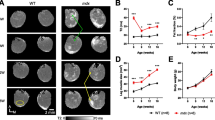Abstract
Magnetic resonance imaging (MRI) is a well-established and widely used technique to characterize and quantify skeletal and cardiac muscle changes in Duchenne muscular dystrophy (DMD). Recently, MRI has been explored to study disease progression and response to gene therapy in the canine DMD model. Using traditional sequences, delayed gadolinium enhancement, novel sequences, and spectroscopy, investigators have begun to (i) establish the baseline MRI characteristics of the muscles in normal and affected dogs and (ii) evaluate gene therapy outcomes in treated dogs. As a noninvasive assay, MRI offers an excellent opportunity to study longitudinal muscle changes in long-term gene therapy studies in the canine model. In this chapter, we outline the MRI method used to study DMD in the canine model.
Access this chapter
Tax calculation will be finalised at checkout
Purchases are for personal use only
Similar content being viewed by others
References
Dahlqvist JR, Widholm P, Leinhard OD et al (2020) MRI in neuromuscular diseases: an emerging diagnostic tool and biomarker for prognosis and efficacy. Ann Neurol 88(4):669–681. https://doi.org/10.1002/ana.25804
Jungbluth H (2017) Myopathology in times of modern imaging. Neuropathol Appl Neurobiol 43(1):24–43. https://doi.org/10.1111/nan.12385
Mercuri E, Pichiecchio A, Allsop J et al (2007) Muscle MRI in inherited neuromuscular disorders: past, present, and future. J Magn Reson Imaging 25(2):433–440. https://doi.org/10.1002/jmri.20804
Aivazoglou LU, Guimaraes JB, Link TM et al (2021) MR imaging of inherited myopathies: a review and proposal of imaging algorithms. Eur Radiol. https://doi.org/10.1007/s00330-021-07931-9
Duan D, Goemans N, Takeda S et al (2021) Duchenne muscular dystrophy. Nat Rev Dis Primers 7:13
Alic L, Griffin JFT, Eresen A et al (2021) Using MRI to quantify skeletal muscle pathology in Duchenne muscular dystrophy: a systematic mapping review. Muscle Nerve 64(1):8–22. https://doi.org/10.1002/mus.27133
Power LC, O’Grady GL, Hornung TS et al (2018) Imaging the heart to detect cardiomyopathy in Duchenne muscular dystrophy: a review. Neuromuscul Disord 28(9):717–730. https://doi.org/10.1016/j.nmd.2018.05.011
McGreevy JW, Hakim CH, McIntosh MA et al (2015) Animal models of Duchenne muscular dystrophy: from basic mechanisms to gene therapy. Dis Model Mech 8(3):195–213. https://doi.org/10.1242/dmm.018424
Duan D (2015) Duchenne muscular dystrophy gene therapy in the canine model. Hum Gene Ther Clin Dev 26(1):57–69. https://doi.org/10.1089/humc.2015.006
Kornegay JN (2017) The golden retriever model of Duchenne muscular dystrophy. Skelet Muscle 7(1):9. https://doi.org/10.1186/s13395-017-0124-z
Thibaud JL, Monnet A, Bertoldi D et al (2007) Characterization of dystrophic muscle in golden retriever muscular dystrophy dogs by nuclear magnetic resonance imaging. Neuromuscul Disord 17(7):575–584
Thibaud JL, Azzabou N, Barthelemy I et al (2012) Comprehensive longitudinal characterization of canine muscular dystrophy by serial NMR imaging of GRMD dogs. Neuromuscul Disord 22(Suppl 2):S85–S99. https://doi.org/10.1016/j.nmd.2012.05.010
Guo LJ, Soslow JH, Bettis AK et al (2019) Natural history of cardiomyopathy in adult dogs with golden retriever muscular dystrophy. J Am Heart Assoc 8(16):e012443. https://doi.org/10.1161/JAHA.119.012443
Yokota T, Lu QL, Partridge T et al (2009) Efficacy of systemic morpholino exon-skipping in Duchenne dystrophy dogs. Ann Neurol 65(6):667–676. https://doi.org/10.1002/ana.21627
Bish LT, Sleeper MM, Forbes SC et al (2011) Long-term systemic myostatin inhibition via liver-targeted gene transfer in golden retriever muscular dystrophy. Hum Gene Ther 22(12):1499–1509. https://doi.org/10.1089/hum.2011.102
Bish LT, Sleeper MM, Forbes SC et al (2012) Long-term restoration of cardiac dystrophin expression in golden retriever muscular dystrophy following rAAV6-mediated exon skipping. Mol Ther 20(3):580–589. https://doi.org/10.1038/mt.2011.264
Barbash IM, Cecchini S, Faranesh AZ et al (2013) MRI roadmap-guided transendocardial delivery of exon-skipping recombinant adeno-associated virus restores dystrophin expression in a canine model of Duchenne muscular dystrophy. Gene Ther 20(3):274–282. https://doi.org/10.1038/gt.2012.38
Kornegay JN, Li J, Bogan JR et al (2010) Widespread muscle expression of an AAV9 human mini-dystrophin vector after intravenous injection in neonatal dystrophin-deficient dogs. Mol Ther 18(8):1501–1508. mt201094 [pii] 1038/mt.2010.94
Hayes J, Veyckemans F, Bissonnette B (2008) Duchenne muscular dystrophy: an old anesthesia problem revisited. Paediatr Anaesth 18(2):100–106. https://doi.org/10.1111/j.1460-9592.2007.02302.x
Acknowledgments
The research on the canine DMD model in the Duan lab is currently supported by the National Institutes of Health (NS-90634 and AR-70517), Jesse Davidson Foundation-Defeat Duchenne Canada, Hope for Javier, Jackson Freel DMD Research Fund, Parent Project Muscular Dystrophy, Jett Foundation, Michael’s Cause, Ryan’s Quest, Solid Biosciences Inc., and the University of Missouri.
Disclosure
DD is a member of the scientific advisory board for Solid Biosciences and equity holders of Solid Biosciences. DD is a member of the scientific advisory board for Sardocor Corp. In the last 3 years, the Duan lab has received research supports unrelated to this project from Solid Biosciences and Edgewise.
Author information
Authors and Affiliations
Corresponding author
Editor information
Editors and Affiliations
Rights and permissions
Copyright information
© 2023 The Author(s), under exclusive license to Springer Science+Business Media, LLC, part of Springer Nature
About this protocol
Cite this protocol
Zalcman, A.R., Hakim, C.H., Lattimer, J.C., Holland, J.R., Dodam, J.R., Duan, D. (2023). MRI Evaluation of Gene Therapy in the Canine Model of Duchenne Muscular Dystrophy. In: Maruyama, R., Yokota, T. (eds) Muscular Dystrophy Therapeutics. Methods in Molecular Biology, vol 2587. Humana, New York, NY. https://doi.org/10.1007/978-1-0716-2772-3_17
Download citation
DOI: https://doi.org/10.1007/978-1-0716-2772-3_17
Published:
Publisher Name: Humana, New York, NY
Print ISBN: 978-1-0716-2771-6
Online ISBN: 978-1-0716-2772-3
eBook Packages: Springer Protocols




